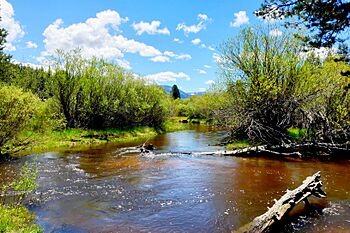Trout Creek (Lake Tahoe) facts for kids
Quick facts for kids Trout Creek |
|
|---|---|
 |
|
| Country | United States |
| State | California |
| Region | El Dorado County |
| Physical characteristics | |
| Main source | West side of Armstrong Pass in the Carson Range of the Sierra Nevada 8,630 ft (2,630 m) 38°50′01″N 119°54′49″W / 38.83361°N 119.91361°W |
| River mouth | Lake Tahoe South Lake Tahoe, California 6,224 ft (1,897 m) 38°56′28″N 119°59′48″W / 38.94111°N 119.99667°W |
| Basin features | |
| Tributaries |
|
Trout Creek is a stream in California, United States. It flows north from Armstrong Pass in the Carson Range. This mountain range is part of the larger Sierra Nevada mountains. Trout Creek eventually flows into Lake Tahoe.
Contents
History of Trout Creek
Trout Creek was a very important place for the Washo people. They are a Native American tribe who lived in this area. The Washo people used the creek as a fall camp. This means they would camp there in the autumn. They came to catch a fish called Mountain whitefish. The Washo name for the creek is Mathocahuw O'tha. This name means "river of the whitefish."
In 1860, a family named George and Adeline Fountain built a log cabin near where the creek starts. This area is still known as "Fountain Place" today.
Where Trout Creek Flows
Trout Creek begins high up in the Sierra Nevada mountains. It starts south of a peak called Freel Peak in the Carson Range.
As it flows, other smaller streams join it:
- Saxon Creek joins Trout Creek in an area called Lake Valley.
- Cold Creek meets Trout Creek at Lake Christopher. This lake was made by building a dam on the creek.
- Heavenly Valley Creek also joins Trout Creek.
After these streams join, Trout Creek flows into Truckee Marsh. Finally, it reaches the southern part of Lake Tahoe. The only natural lake in the Trout Creek area is Star Lake. The entire area that drains into Trout Creek is about 106 square kilometers. The main part of the creek is about 19.5 kilometers long. Cold Creek, one of its branches, starts very high up at Freel Peak, about 10,884 feet (3,317 meters) high.
Protecting Trout Creek's Environment
A big project was finished in 2001 to help Trout Creek. It was called the Trout Creek Stream Restoration and Wildlife Enhancement Project. This project helped make the creek a better home for plants and animals.
Workers rebuilt over 3,000 meters of the creek. They made it more winding and raised its level. This helped the water spread out more into the surrounding land. The goal was to improve the habitat for animals and plants. It also helped raise the water level in the ground nearby. The United States Forest Service has been studying this project. They want to see how well it helped reduce dirt and other stuff flowing into the creek.
Beavers and Their Role
North American beavers live in parts of Trout Creek and Cold Creek. Beavers were brought back to the Lake Tahoe area between 1934 and 1949. This was done to help prevent damage to streams and to restore wetlands. Wetlands are important areas where water covers the land.
Beaver dams can be very helpful. Studies have shown that beaver dams can increase the number or size of fish, like trout. This was seen in a study of fish in Sagehen Creek. This creek is similar to Trout Creek.
Beavers also help the environment in other ways:
- They help remove dirt and pollution from the water. This makes the lake water clearer.
- Plants like aspen and cottonwood trees grow well near beaver dams.
- Recent studies show that more leafy plants and grasses grow near beaver dams.
When beaver dams were removed from nearby Taylor Creek and Ward Creek, the water in Lake Tahoe became less clear. This shows how important beavers are for keeping the lake healthy.

